In this exclusive sit-down interview with New Canadian Media reporter Abbas Somji, Toronto Mayor John Tory addresses visible minority representation on city council, the carding controversy and improving settlement services.
(Media Credit: Absolute Mediaworks/Abbas Somji)
John Tory walks into his expansive office, which looks directly out onto Toronto’s Nathan Phillips Square. He says visitors (and even media) entering City Hall through the iconic rotunda’s main entrance sometimes look up and spot him through the clear window, hunched over his desk, scanning one of many reports scattered across it.
“They shoot pictures of me in the window and say, ‘Well, there he is. He’s at his desk,’” says Tory, quoting a television broadcaster. “They call it the ‘MayorCam,’” he adds, matter-of-factly.
It’s been half-a-year since Tory took office as Mayor of Toronto.
These days, he says he averages 15-hour days, spent partly at the office, and partly meeting residents, business owners, schools and community groups, all across Toronto – including in so-called “Ford Country”.
“I would think if you put on a map everywhere I’ve been in the six months – first of all, it’d be a lot of dots on the map, but secondly, those dots would be all over the city.”
“I know [settlement agencies] have been the subject of debate and sometimes cutbacks,” says Tory, admitting there’s a need for more programs, particularly those that assist new arrivals and their children get acquainted with the school system in Canada.
It’s the sort of insight he says he needs in order to learn about the concerns facing Toronto residents, especially in the case of newcomers. Issues surrounding integration often take precedence in these discussions – shoestring budgets mean recent immigrants have fewer resources available in adjusting to life in Canada.
“I know [settlement agencies] have been the subject of debate and sometimes cutbacks,” says Tory, admitting there’s a need for more programs, particularly those that assist new arrivals and their children get acquainted with the school system in Canada.
“People sometimes complain there’s too many of those programs. Wrong. There isn’t enough of that kind of initiative to help people to adjust themselves faster and better.”
Why City Council Doesn’t Look Like the City
There’s also the concern some community-related issues may get overlooked, simply because there isn’t anyone representing those groups in council. Tory is one of 39 White members of Toronto city council. Only six councillors who serve the GTA come from visible minority communities – a poor reflection of the city’s cultural make-up of the city, especially as more than half of its residents were born outside Canada.
“[T]he more the city council, the police service, the fire service, the different boards, the business community are representative of the population as a whole, the more legitimate they will be in being able to carry out their responsibilities and the more they will understand themselves about the challenges facing newcomers.”
“You can’t just snap your fingers and say, ‘Lo and behold, the city council will look different,’” says Tory, determined to make progress on recruitment efforts.
“We’ve got to encourage more of that to happen because the more the city council, the police service, the fire service, the different boards, the business community are representative of the population as a whole, the more legitimate they will be in being able to carry out their responsibilities and the more they will understand themselves about the challenges facing newcomers.”
Tory says he led and initiated a program called “School for Civics” as part of Civic Action, geared specifically to people from visible minority community groups. The goal was to put them in a room with people from all parties, who could answer questions about what it was like to run a campaign, and to help them get comfortable with the idea of running for public office.
Tory says, “Even people who have been here for generations are afraid of running for office because they think, ‘Well, I don’t know about this,’ and ‘How will I be treated?’ and ‘Where will I get volunteers?’”
He says participants walked away with a fresh take on civic engagement.
“Even that provided a little bit of comfort to people who were feeling a little bit like, ‘I just came here 10 years ago and I really don’t know the political system here very well,’” Tory says.
The Carding Controversy
The mayor’s performance is being scrutinized now more than before, over the way he handles some contentious issues. The subject of “carding” – or random “street checks” police use to collect information about those who are stopped and questioned – has drawn the ire of many a resident, prompting public outcry from a number of visible minority communities.
“I take it as my responsibility, because I always said during the election, [carding] would be a policy that was in need of continuous reform, because as you add more and more people from more and more places and as policing changed over time and you learned more things, that you had to keep reforming it and improving it.”
Tory says carding started off as “a well-intentioned policy” to help foster a good relationship between police and communities.
He says he thinks the policy “unintentionally” impacted a disproportionate number of young Black and Brown men, while aiming for it to be “bias-free policing.”
“I accept the fact that a lot of people are dissatisfied, especially in the Black community, with that policy,” says Tory.
“And so, I take it as my responsibility, because I always said during the election, this would be a policy that was in need of continuous reform, because as you add more and more people from more and more places and as policing changed over time and you learned more things, that you had to keep reforming it and improving it.”
Tory says he’s committed to working on the issue with Toronto’s new police chief, Mark Saunders, in coming up with reforms that better serve the community.
Toronto, A Beacon of Hope
Tory is effusive in the role immigrants have played in Toronto’s evolution to what it is today – so much so that he’s dedicated a day in their honour. Festivities for the first-ever “Toronto Newcomer Day” kicked off on May 29 at Nathan Phillips Square, celebrating all that new immigrants have done to enrich the cultural fabric of the city.
“I think it also reminds us that [when] we invite all these newcomers to come – this is an area we haven’t done so well – that we have an obligation to make sure they get better settled here and have easier access.”
Tory says Torontonians have a long-standing history of embracing newcomers, an acceptance that dates back to the Underground Railroad, which brought enslaved African-Americans in the U.S. to freedom in Canada, as well as in the 1960s when the country took a strong stance against apartheid in South Africa.
“[Toronto] probably became a beacon of hope for the world,” says Tory. “We learned so much from each other and it brought this vibrancy to the city.”
Still, he insists there’s much work to be done.
“I think it also reminds us that [when] we invite all these newcomers to come – this is an area we haven’t done so well – that we have an obligation to make sure they get better settled here and have easier access,” says Tory.
“I think we owe it to people to do a better job than we have been doing at that.”




